Big Bubble Process
The following is an introductory overview from the Big Bubble Circulation (BBC) organization that contains three documents originally drafted by Jerry Kellgren, Ch.E. which will familiarize you with the processes that the patented (U.S. Utility Patent #11,267,735) BBC aeration product addresses.
- BBC Air Sparging
Documents along with included figures provide an overall description of the processes involved in the operation of both a common diffusion-based Aeration System (AS) and our new Big Bubble Circulation (BBC) product. - BBC vs. AS
Documents and drawings explain the involved bubble mass from the point of creation to the surface. As in the previous binder, overall details and comparisons are given between the common AS and our new BBC. - BBC Efficiency Article
Documents and diagrams that tell the story of the dissolved oxygen content and the disparity of true circulation benefits between the AS and our new patented BBC products.
Add patented Big Bubble Circulation system to significantly improve any lake air sparging system
The typical air sparging system uses small rising air bubbles for both increasing dissolved oxygen levels and circulation of the lake. While small bubbles are great at delivering dissolved air to the water, they are poor at lifting water from the bottom to the surface. By adding Big Bubble Circulation (BBC) to your existing system, your lake water will become significantly healthier.
How typical air systems operate
Typical air sparging systems include compressors, weighted air hoses, and air diffusers (figure 1).
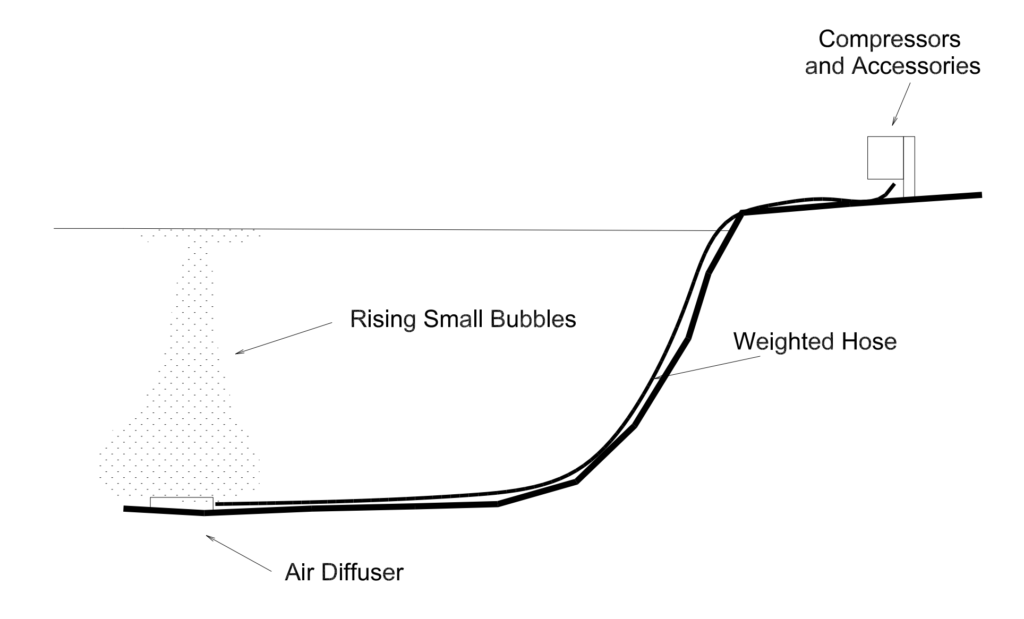
To better understand how small bubbles work, let’s follow the air through the process in a hypothetical lake that is 32 feet deep in the middle, is cold (70 F) on the bottom, and warm (90 F) at the surface (figure 2). Without any recirculation the lake will be low in DO (dissolved oxygen) in the cold water and high in DO at the surface.
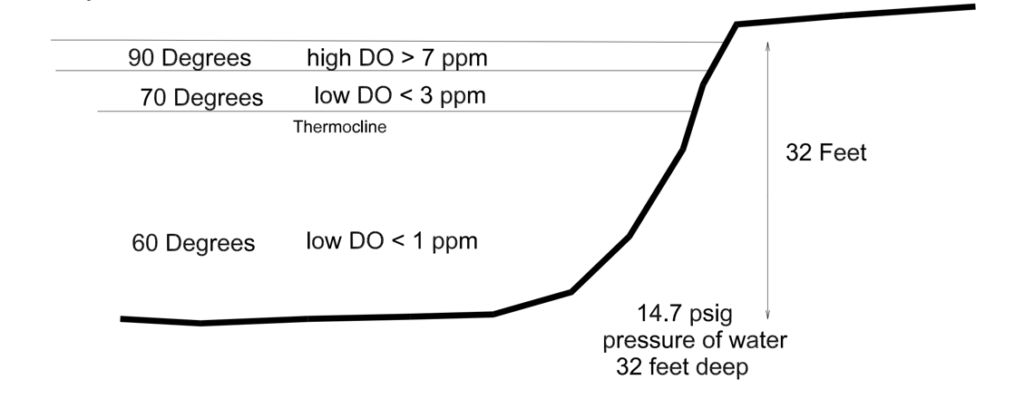
The compressor on the bank feeds pressurized air through the weighted hose to the sparging unit where millions of small bubbles are released into the lake’s coldest water. The diameter of the bubbles range in size from approximately 1 mm to about 20 mm. Due to this small size, buoyancy is also minimal. As the mass of bubbles starts moving upward, the larger bubbles rise faster. Many of the smaller bubbles dissolve directly into the cold low oxygen water releasing their gas. As the faster bubbles move upward, they create a lower pressure wake which other bubbles follow. Some bubbles will collide forming slightly larger bubbles and some bubbles will zig-zag and spiral as they follow other bubbles (figure 3).
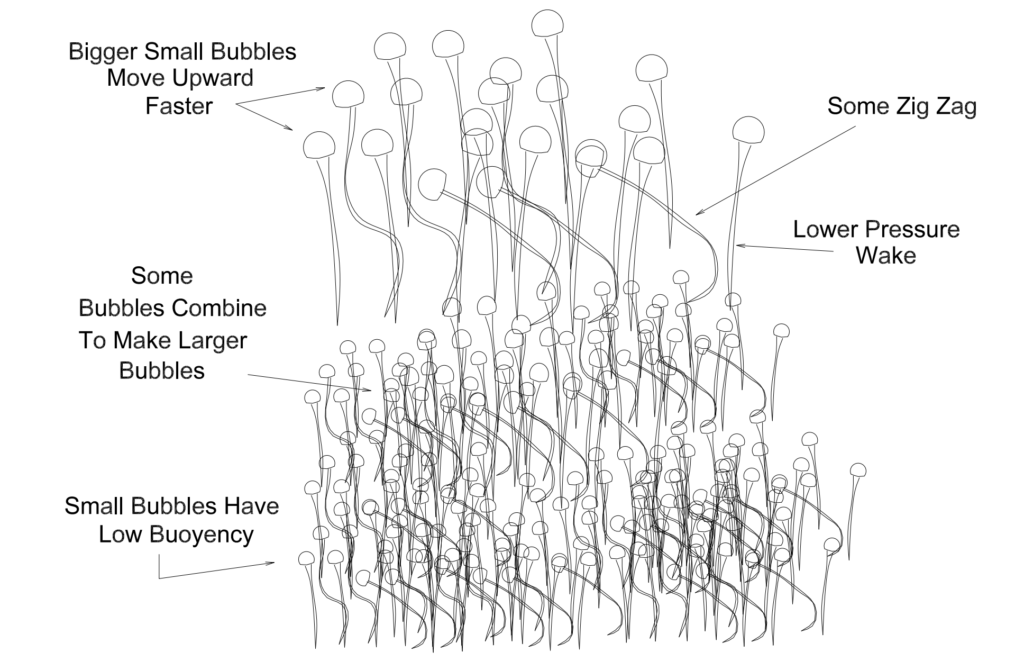
The bubble mass will rise to the surface pushing and dragging water upward. The amount of water transported from the bottom of the lake to the surface is proportional to the size and velocity of the rising bubbles (figure 4).
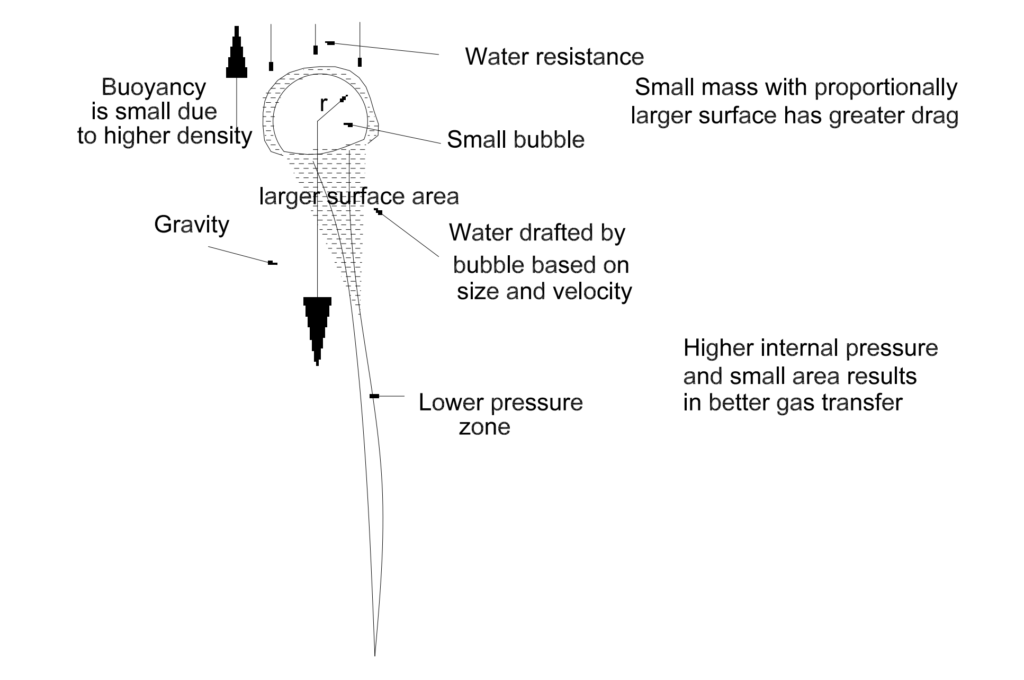
Only the larger bubbles that haven’t dissolved reach the surface. This causes minimal mounding (rise above normal lake level indicating flow) as the water moves outward across the surface (figure 5).
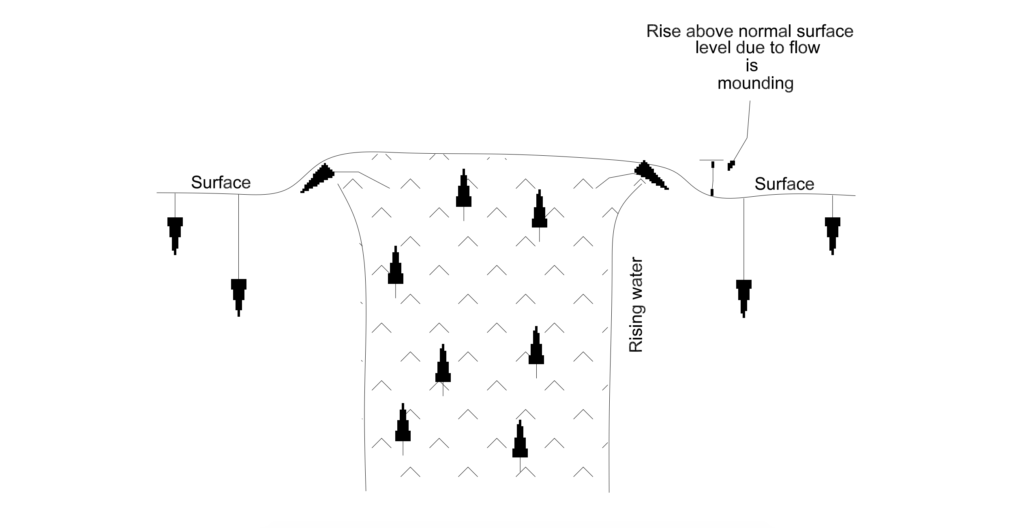
Patented Big Bubble Circulation
With patented Big Bubble Circulation (BBC) there are no moving parts and the unit can easily be added to most standard air sparging systems (figure 6).
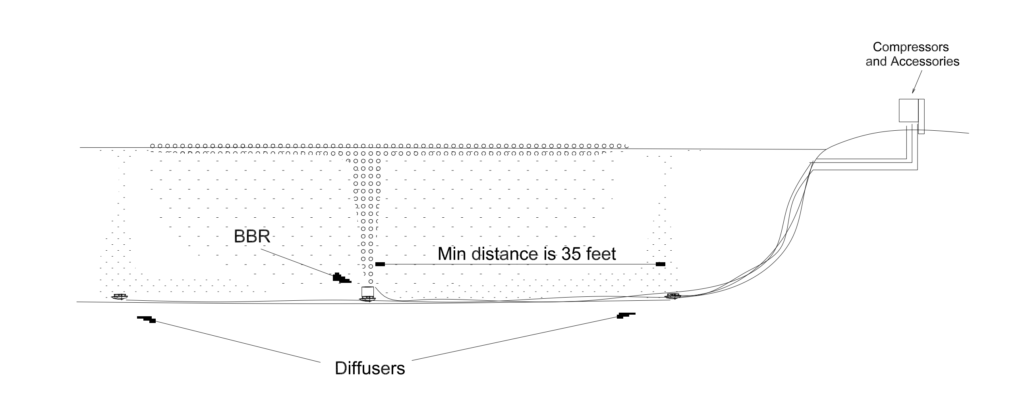
A separate weighted hose can be run from the control cabinet to the lake bottom or one of the existing diffuser stations can be replaced by the BBC. The BBC will usually be placed at the deepest part of the lake. Any other diffusers stations should circle the BBC at a minimum distance of 30 feet.
The air flow from the compressor cabinet can be adjusted so that up to 60% of the air flow will go to the BBC. The remaining air will be divided among the diffuser stations. When starting the system, it is important to slowly open the air valves to prevent slamming the BBC or air diffuser stations.
The air flow from the compressor cabinet can be adjusted so that up to 60% of the air flow will go to the BBC. The remaining air will be divided among the diffuser stations. When starting the system, it is important to slowly open the air valves to prevent slamming the BBC or air diffuser stations.
The BBC operates by filling an internal surge chamber from air inlets 180 degrees apart. The surge chamber fills with air until it reaches the discharge tube opening. Once the air enters the discharge tube, the whole surge chamber quickly empties up the discharge tube producing large bubbles (figure 7).
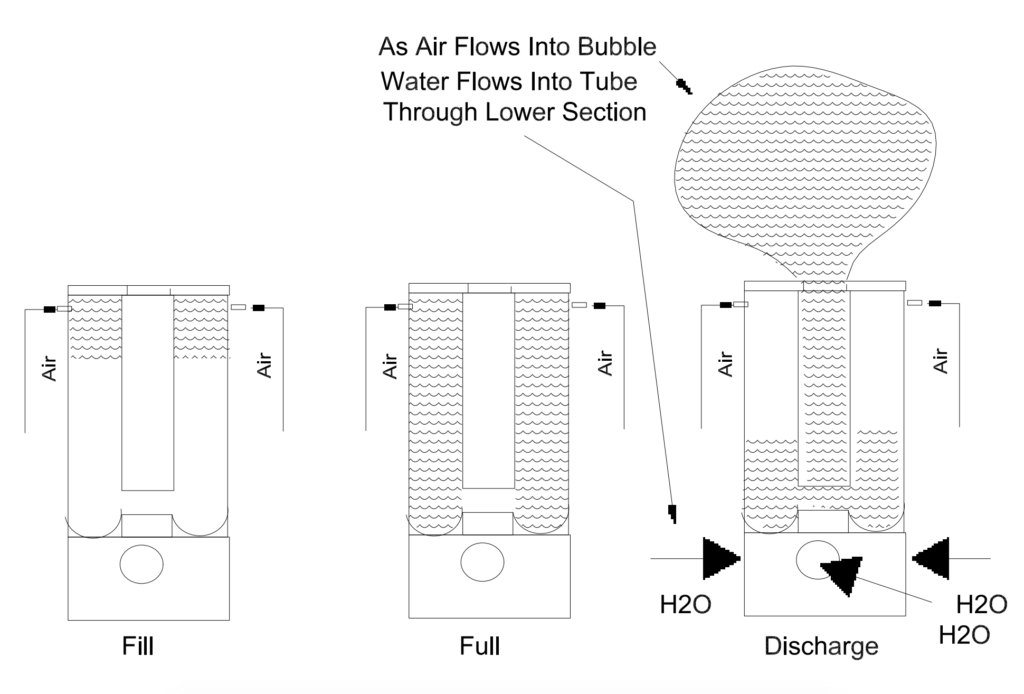
The large bubbles will start rising straight to the surface and expanding. As the big bubble expands it gets lighter and goes faster to the surface (up to 10 ft./sec). The upper part of the fast-moving bubble lifts water while the lower part creates a low-pressure area under the bubble which drafts water (figure 8).
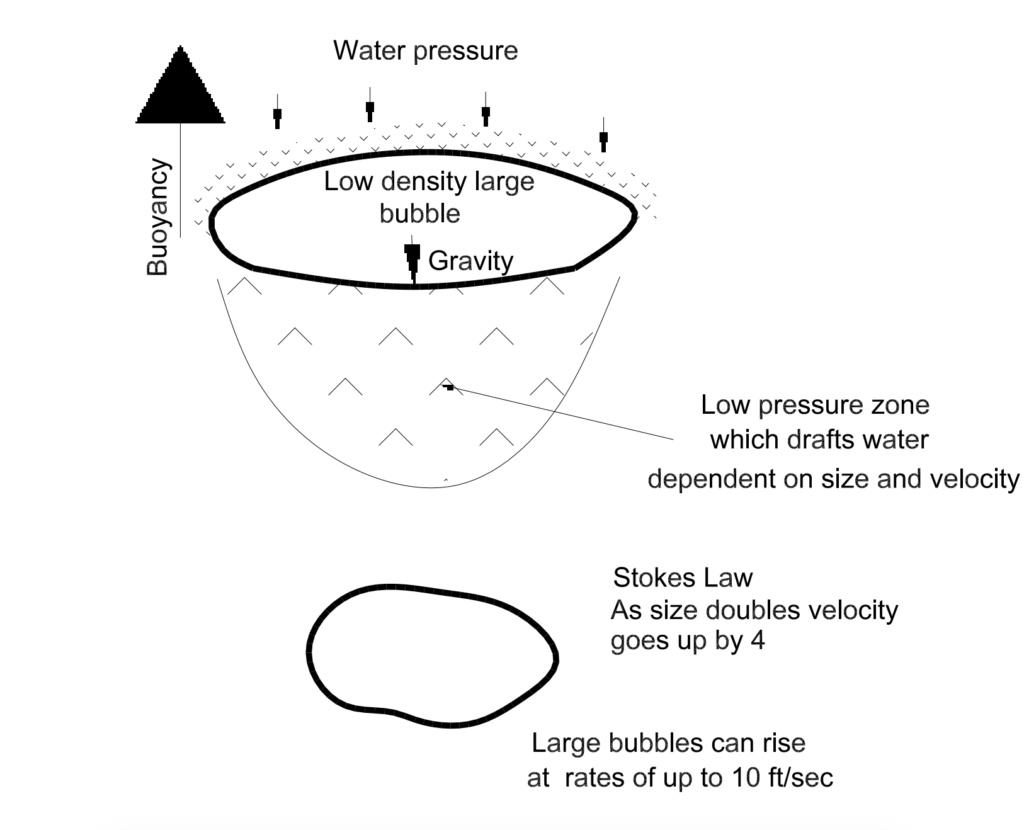
Big bubbles lift over 500% more water to the surface than do small bubbles. The big bubbles create a significant mounding and disturbance as they reach the surface. The more the lake recirculates from the lake bottom to the surface, the healthier the lake will be.
Optimal air sparging and circulation system
Because cold water holds more dissolved oxygen than warm water, the diffuser stations will be used to create small bubbles in the coldest water. These bubbles will start degassing which adds oxygen to the water. The remaining bubbles will move across the bottom of the lake towards the low-pressure zone created around the BBC while degassing all the way (figure 9).
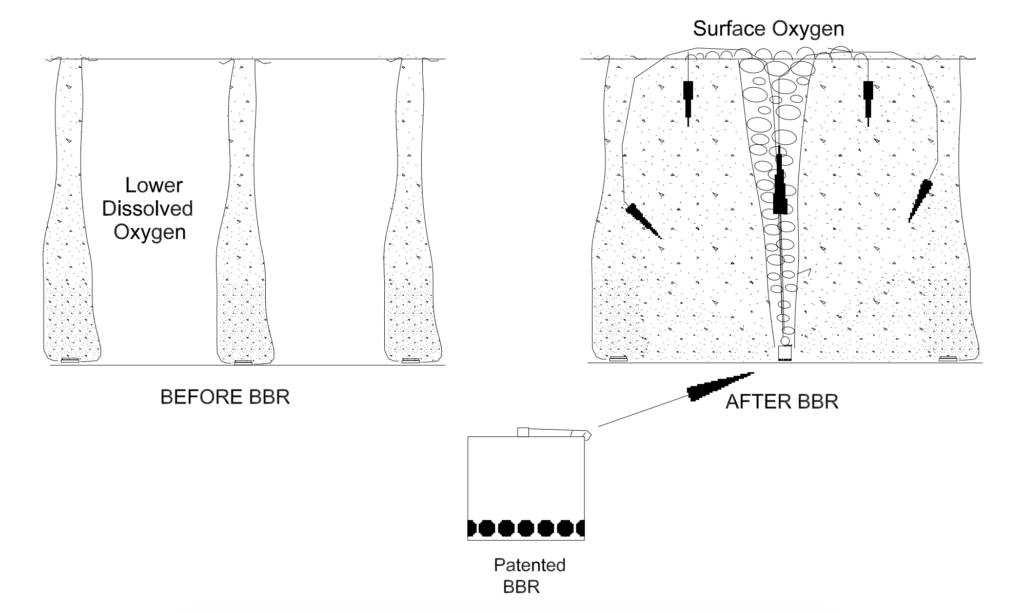
The last of the remaining small bubbles will be drawn into the BBC where they are carried to the surface by the flowing stream of water. As the cool water moves across the surface of the lake, oxygen will diffuse from the air into the water. This water will create a top-down circulation pattern between diffuser stations which evenly distributes the dissolved oxygen required for a much healthier lake.
Conclusion
Whether you have an existing air sparging system or you are ordering a new one, adding patented Big Bubble Circulation will improve the systems efficiency and give the owner a significantly healthier lake.
Big Bubble Circulation vs. Conventional Aeration for pond or lake oxygenation
Discussion of conventional aeration bubbles
Before discussing how Big Bubble Circulation (BBC) compares with Conventional Aeration (CA), let’s look at CA air bubbles generated in low-oxygen water (< 1 ppm O2) (drawing 1)
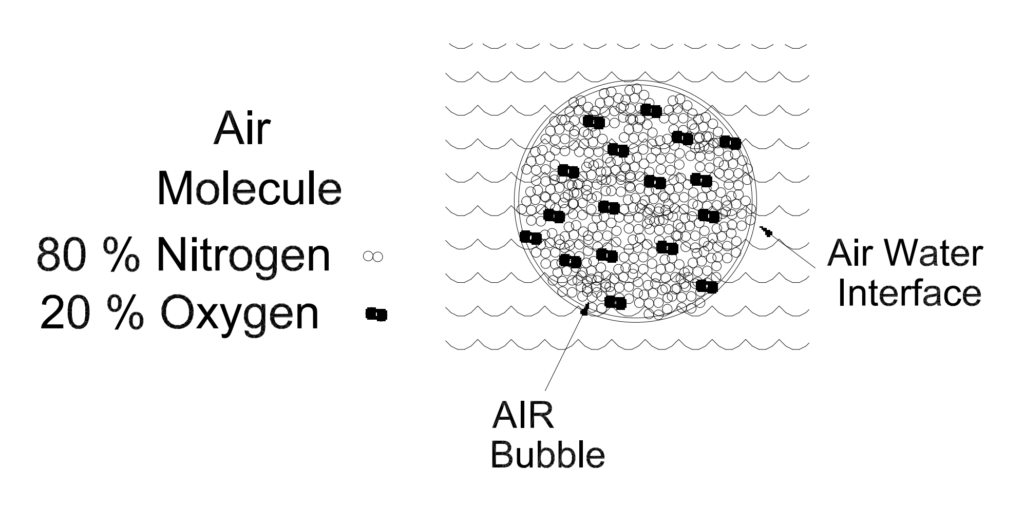
The small diameter CA bubble (< 2 cm) of air in water is roughly 80% Nitrogen and 20% Oxygen. The air inside the bubble is separated from the water by a layer which is both air and water. This means that for the molecule of oxygen to transfer from the gas phase to the water phase, the oxygen molecule must be at the interface where it can dissolve into the water. The transfer rate of oxygen from the gas to water phase is dependent on the concentration of oxygen in the water. The larger the difference between the concentration of oxygen in the air to water, the faster the transfer. This mechanism is why many of the micro-bubbles of air emitted from a CA diffuser never make it to the surface. They dissolve on the assent to the surface through the lower oxygen water. Because a large volume of air is required and since the air is only 20% oxygen, it is not the most efficient method of adding oxygen to the lake water.
If all the bubbles stayed the same small size that they were generated in by the CA, almost none would make it to the surface because they’re not buoyant enough. Bubbles made by the CA combine to make bubbles large enough to rise to the surface. These round bubbles carry a thin film of colder low-oxygen water from the lower depths to the surface. This water then contacts the air and absorbs oxygen as it flows a short distance across the surface before sinking back into the lake. This is natural circulation within the body of water. No matter what the published circulation rates by the manufacturers are, their claims of thousands of gallons of circulation just aren’t true either in theory or by visual evidence at the surface.
Ironically, because air is only 20% oxygen, the massive number of microbubbles that dissolve into the lake going from the bottom to the surface don’t add that much dissolved oxygen. The cold water which flows across the surface for a short distance absorbs significantly more dissolved oxygen than all the CA generated bubbles that were absorbed into the lake. The secret then to a healthier pond or lake is to increase the distance where the cool water from lower depths in the lake flows across the surface absorbing dissolved oxygen.
Whether you have an existing air sparging system or you are ordering a new one, adding patented Big Bubble Circulation will improve the systems efficiency and give the owner a significantly healthier lake.
Comparison of BBC to CA
This example will compare a 14-inch BBC to any single diffusor within an existing CA system working today. One of the existing diffusers will be replaced by the 14-inch BBC. For this example, the body of water will be 32 feet deep
After 3 seconds
The CA will be the first to make bubbles because the compressed air from the surface compressor will pass through the diffuser and start producing bubbles while the BBC is filling. The CA bubbles will be less than 2 cm. and round. The small bubbles which are barely buoyant will accumulate above the diffuser in a tight cluster which gets wider as it moves upward through the water (drawing 2).
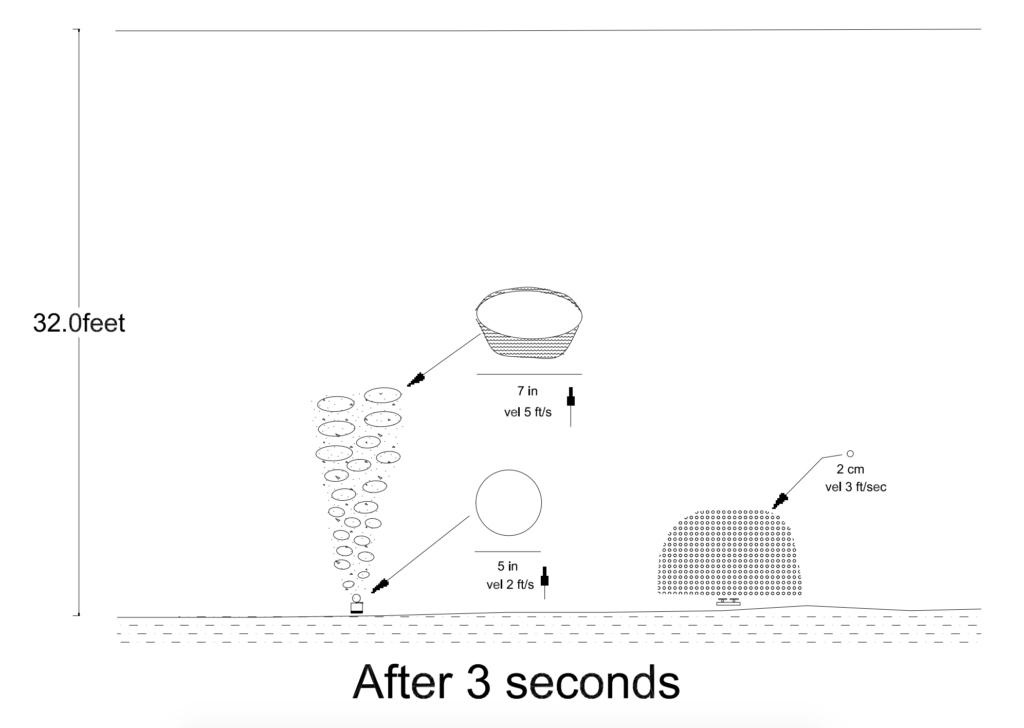
The bubbles nearer the center will start combining into slightly larger and lighter bubbles as the mass moves upwards. The CA will generate bubbles very soon after the system is activated. The compressed air from the surface compressor will quickly pass from the distribution header down its weighted hose to the existing diffusor to start producing bubbles. The diameter of the round bubbles that are formed from the water at the diffuser will be less than 2 cm. These small bubbles which are barely buoyant accumulate above the diffuser in a tight cluster which gets wider as it moves upward through the water. The bubbles near the center start combining into slightly larger bubbles as the cluster moves upward. After 3 seconds, the bubbles at the center will still be circular, approximately 2 cm. in size, and moving at 1-3 ft./sec. Since the bubbles are circular, they cannot be lifting water. Approximately 20% of the bubbles will dissolve into the surrounding water as they are formed. This creates a zone of dissolved oxygen enriched water around the cluster of rising bubbles.
The BBC which replaces an existing diffuser unit in the system must fill with air before generating bubbles. The BBC will fill with air from the compressor header through the weighted hose connected to the top of the BBC. As the water exits the BBC chamber through the four-inch pipe, the air forms a round 5-inch bubble. When the 5-inch bubble moves from the pipe into the lake, it tears away from the following air forming a series of small bubbles.
The 5-inch round bubble surrounded by smaller bubbles quickly flattens out as it pushes water upward. This big bubble quickly rises towards the surface expanding in size and increasing in velocity. According to Stokes Law regarding bubbles moving through water, for every doubling of size the velocity of the bubble increases by four.
After 3 seconds, this large elliptical bubble has risen over 14 feet, gone from 5 inches to 7 inches, and increased in velocity from 2 to 5 feet/sec. This increase in size and velocity results in a drag force forming that allows the bubble to lift and draft water simultaneously. After three seconds, the 7-inch bubble is moving almost a pint of low oxygen cool water towards the surface. Compared to small bubbles, there is very little gas transfer from the large bubbles to the water due to the small surface area. Therefore, most of the air is utilized for circulation.
After 6 seconds
The CA system is developing a slow-moving column of small spherical bubbles rising towards the surface. The highest bubble density exists within the first 5 feet of the diffuser and is opaque. The diameter of the bubbles within the cluster is less than 2 cm. The smallest bubbles are dissolving, increasing the dissolved oxygen in the surrounding water. The larger bubbles are combining to make even larger bubbles which move toward the surface (drawing 3).
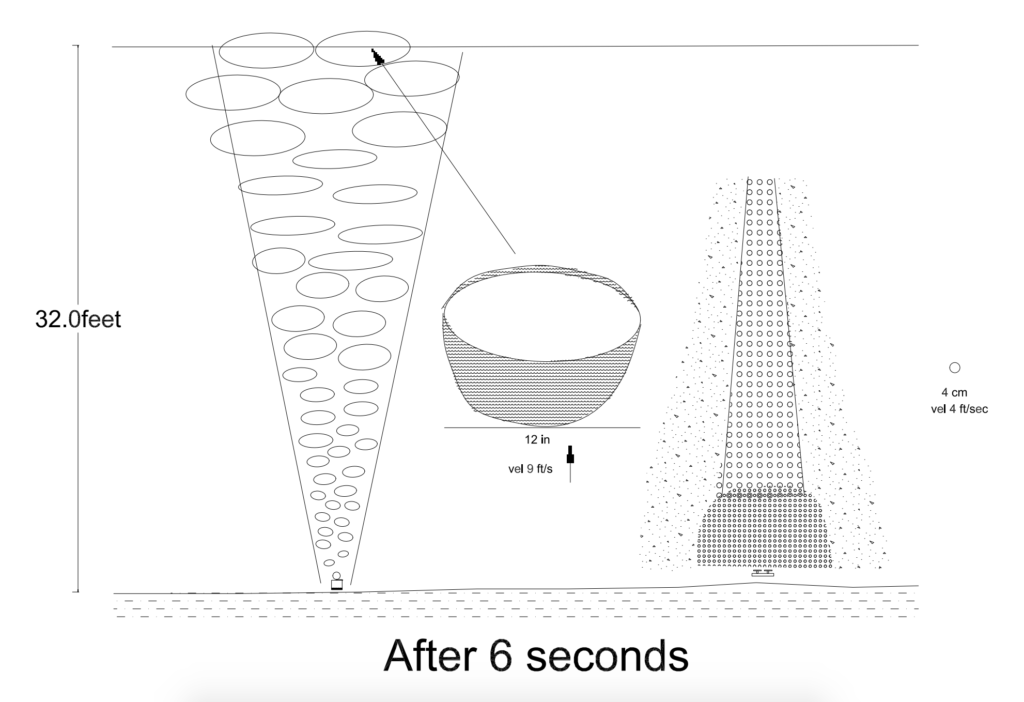
Between 5 and 20 feet above the diffuser, the column is composed of spherical bubbles with a diameter of between 2 to 5 cm. The column is less dense and is not opaque. This less dense section of larger spherical bubbles is traveling at a speed of 4 ft/sec and has reached a height of 24 feet above the bottom after 6 seconds. This section doesn’t lift much water because the bubbles stay spherical with only a small layer of water being carried on each bubble.
After six seconds the BBC bubbles could potentially reach a size of 12 inches and have broken the surface of the lake. The bubbles are elliptical due to the amount of water being lifted. The bubbles have now reached a velocity of 9 ft/sec. This allows the drafting of ½ gallon or more of water by each large bubble. In addition, each large bubble may carry almost a gallon of water to the surface of the lake. Due to the large bubbles increasing in size and velocity, they draft water equally from the bottom of the lake to the surface. This is natural circulation.
As these large bubbles break the surface of the lake, a visible rise of turbulent water will occur due to the water being lifted and drafted by the fast-moving bubbles and pour out in all directions across the surface. The higher the rise of this water, the farther this heavy cold water will flow absorbing oxygen from the atmosphere before sinking into the lake. A 14-inch BBC should flow at least 30 feet in all directions.
After 10 seconds
The CA system has finally breached the surface. The bubbles have combined enough to form some 6 cm bubbles which reach the surface at a velocity of 5 ft/sec. These bubbles are still nearly spherical so they’re not carrying much water. A limited number of bubbles may reach the surface in shallower lakes resulting in some circulation. There may be 300 GPM of water being recirculated, but not the 3400 GPM or more claimed by multiple manufacturers of small bubble diffusion systems (drawing 4).
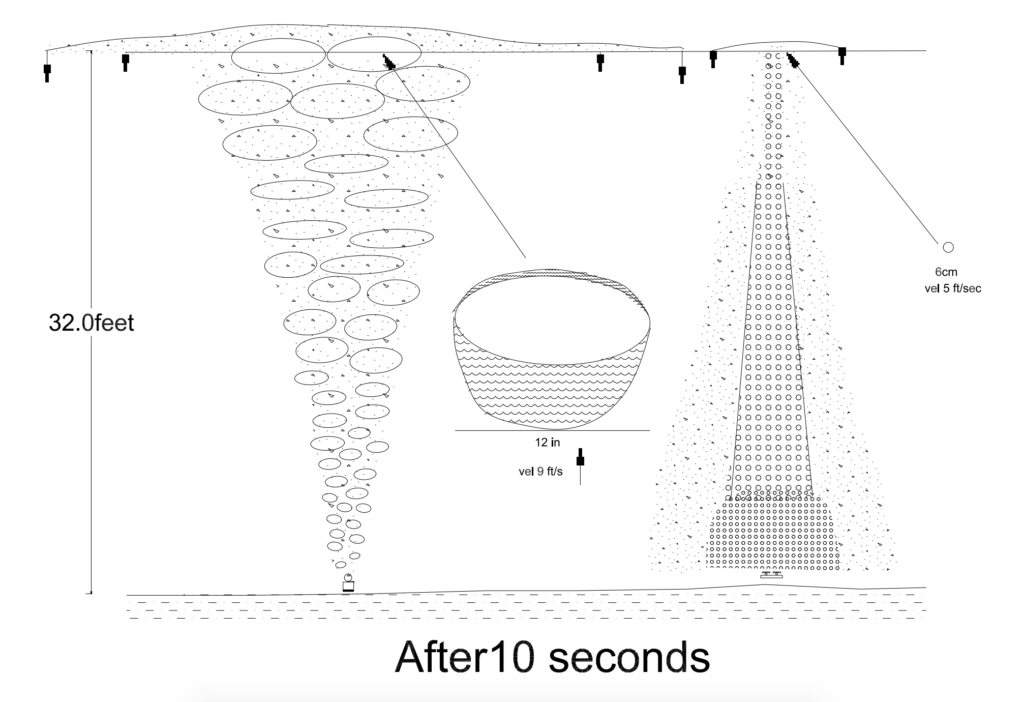
The rise of the water is minimal at the surface with an outward flow of maybe 10 feet across the surface where dissolved oxygen is absorbed. The actual circulation would be restricted to a fairly limited area.
After 10 seconds, the BBC has established a flow pattern bringing 500 gallons or more of cold low oxygen water from the bottom to the surface. At the surface a visible rise of water occurs (12 inches or more) which flows outwardly across the surface over 30 feet in all directions before sinking into the lake. A large circulation pattern is set up in the lake increasing the dissolved oxygen required for a healthy lake.
In Conclusion
All aeration systems benefit any lake by adding needed dissolved oxygen. Unfortunately, over the last 30 years it was discovered that while massive amounts of small air bubbles introduced into a lake do increase dissolved oxygen as they are absorbed, air is only 20% oxygen which limits its effectiveness.
It was discovered that much more oxygen can be added to the lake through bottom to top circulation as opposed to aeration. When cold low-oxygen water is exposed to the atmosphere large amounts of dissolved oxygen is absorbed.
The patented 14-inch BBC generates large bubbles that create a natural circulation of water within the lake. Whether adding a single 14-inch BBC to any existing small bubble aeration system for more circulation or replacing all the diffusers in a system to get maximum circulation, the 14-inch BBC will make your lake healthier.
Adding a Big Bubble Circulation System to any aeration system can improve surface oxygenation area by approximately 1100%
Small bubble aeration systems recirculate water, but do they move the surface water necessary for optimal oxygen transfer?
Natures System
There is no argument that most of the dissolved oxygen in a lake comes from contact between moving surface water and the air directly above it. The best oxygenation happens when the wind creates waves moving across the body of water. The waves moving across the surface expose oxygen poor water to the air where it absorbs oxygen. This oxygen enriched water builds up when it reaches the shore and then flows back down into the lake. The water then moves back across the lake under the surface and repeats the process at the opposite shore; thus, creating circulation throughout the lake (diagram 1). Regarding dissolved oxygen, there is no affordable way to do what the wind does.
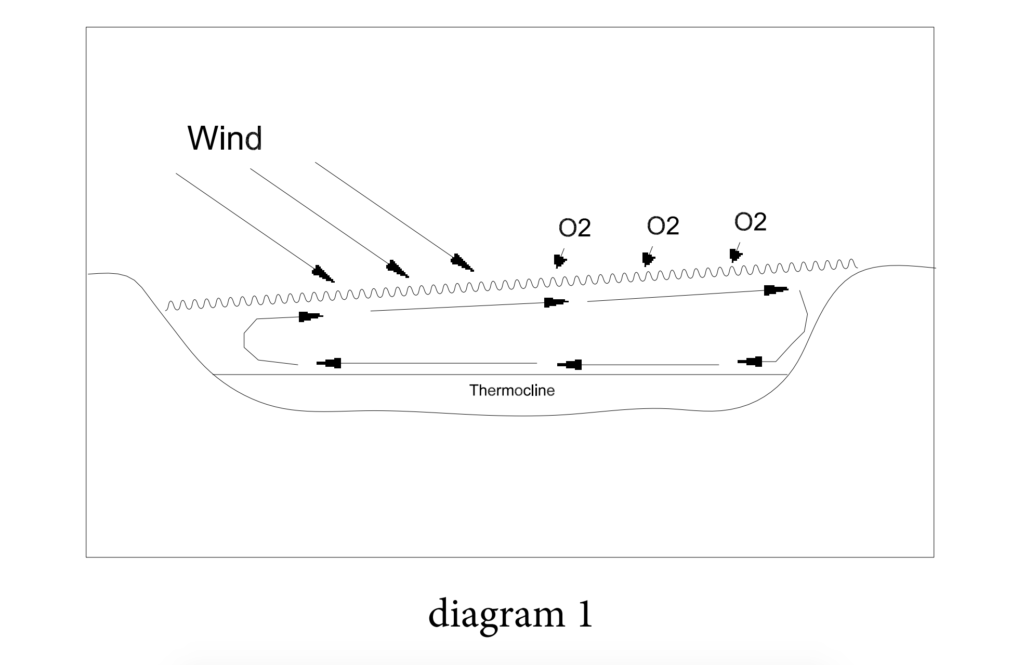
Small Bubble Aeration (AS)
Most small bubble aeration systems are composed of land-based compressor stations that feed pressurized air through weighted air lines to diffusers on the bottom of the lake. These diffusers generate millions of small bubbles that rise and spread out. Most of these bubbles diffuse into the water while slowly moving upward and outward. Only about 20% of the original bubble mass generated will combine to make larger bubbles that make it to the surface.
From a boat on the surface the rising bubbles from below create a turbulent area that mounds above the normal surface level. This mounding creates an outward rolling flow of water across the surface where oxygen can be absorbed from the air. As the circular flow of water from the center moves outward, it slows down allowing the cooler heavier oxygen rich water to sink.
The distance of water flowing outward from the center across the surface is based on the initial mounding (water flows downhill). Small bubble aeration systems create mounding that rarely reaches 3 inches in height. A 3-inch rise in water creates an outward flow of approximately 15 feet. This creates an area of approximately 700 sq. ft. for oxygen transfer (diagram 2a).
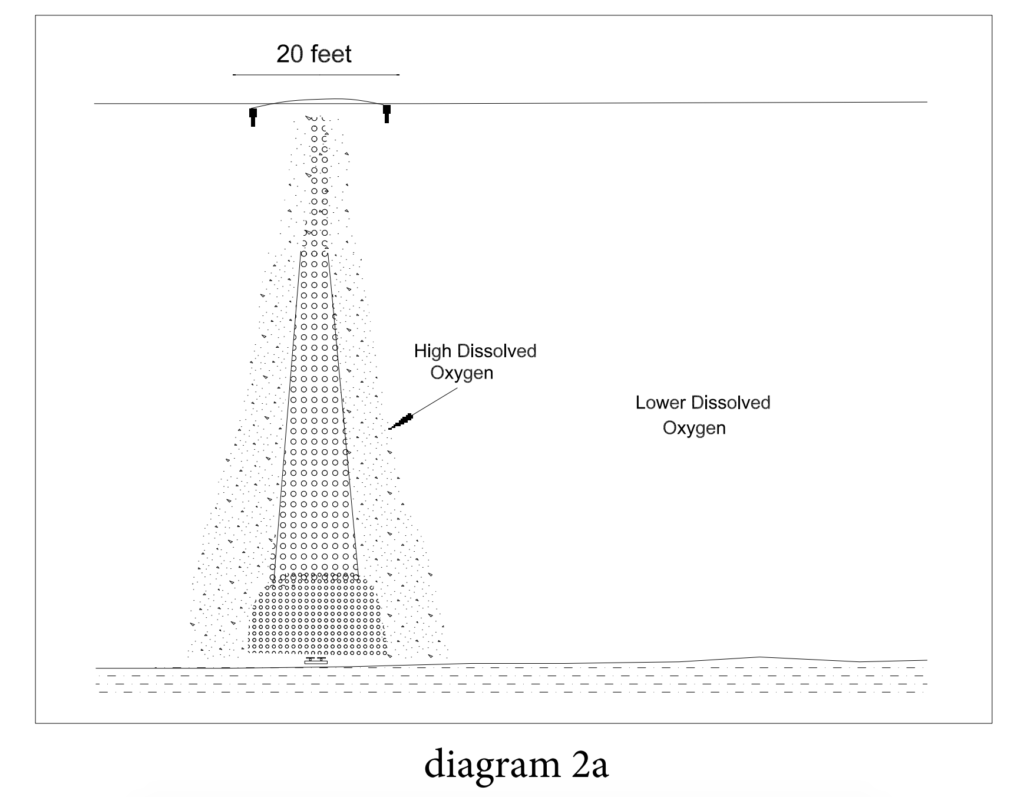
Notes:
- A small bubble aeration system diffuser forms a column of bubbles that slowly rise toward the surface. As referenced in the ‘BBC vs AS details’ article, these small bubbles will not absorb additional oxygen from exposure to the atmosphere at the surface. The bubbles that dissolved before reaching the surface simply oxygenate the surrounding water. The small percentage of the original bubble mass that makes it to the surface is already saturated with oxygen. Therefore, it cannot absorb additional oxygen from the atmosphere.
- The mass of slowly rising dissolving air bubbles creates a column saturated with dissolved oxygen that must be dispersed into the surrounding lake water by diffusion or water currents. This high level of oxygen around the column is evidenced in underwater videos by seeing that the fish tend to gather around the edges of the bubble column.
- The area between the small bubble diffusers can be very low in dissolved oxygen due to organic material, bacteria, or an abundance of fish that also use the dissolved oxygen.
Big Bubble Circulation (BBC)
A BBC can be added to any small bubble aeration system to greatly increase the flow of water across the surface where oxygen is absorbed from the atmosphere. The BBC will create a mounding at the surface of 10 inches or more over a circular area roughly 40 inches in diameter. This mounding will create an outward flow of approximately 50 feet from the center. The BBC will create a zone of approximately 7,800 sq. ft. on the surface for oxygen transfer (diagram 2b).
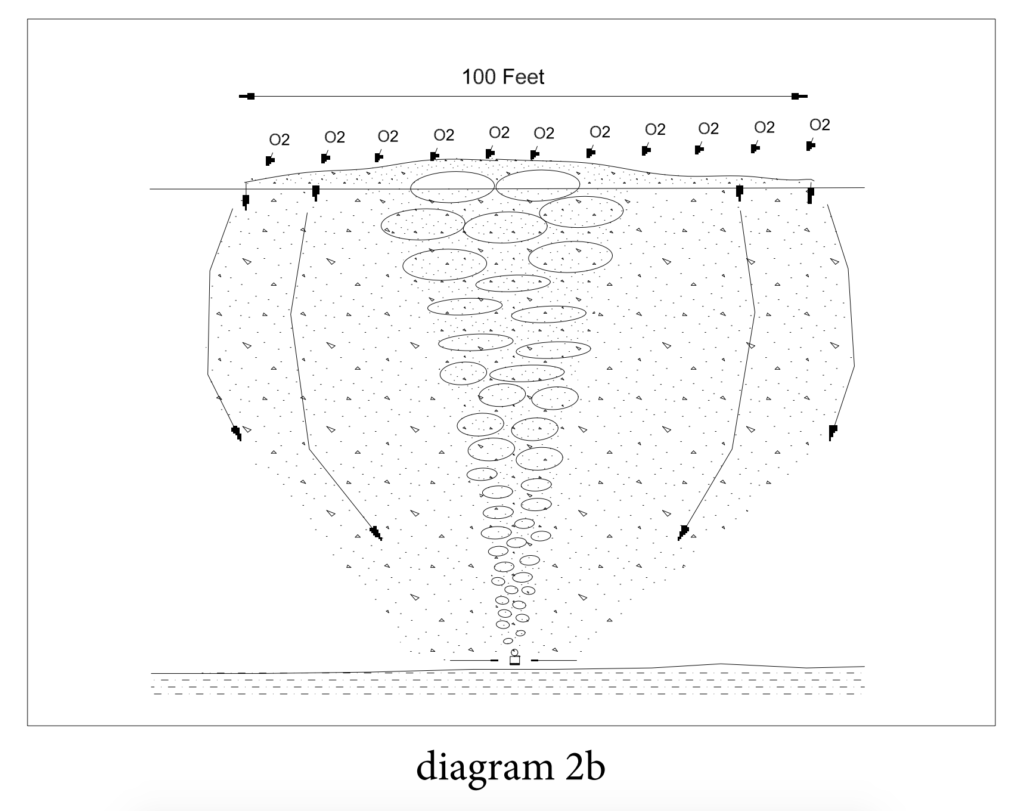
- The patented Big Bubble Circulation device efficiently utilizes expanding air bubbles to lift and draft water from the bottom of the pond or lake to the surface. The cooler, lower oxygen water moves quickly upward until it mounds on the surface creating a 7800 sq. ft. or larger area of moving water for oxygen transfer from the atmosphere to the water. This area of moving water at the surface is approximately 1100% larger than a small bubble aeration system without a BBC. Also, the water (as opposed to the warmer and saturated water delivered by the small bubble aeration systems) is ideal to absorb large amounts of dissolved oxygen from the atmosphere. This now completes a previously unaccomplished step by the small bubble aeration systems—optimal oxygenation.
- The cooler oxygen rich water flows outward until it slows down and sinks back into the lake. This circular area of sinking water creates downward rotation of oxygen rich water in the area between the aeration diffusers that was previously low in oxygen.
- The BBC units added to any existing multi-diffuser system would use approximately 60% of the available compressed air to make big bubbles for moving water to the surface for oxygenation. The remaining air is divided between the existing small bubble diffusers to add oxygen to the subsurface. The BBC units would ideally replace an existing diffuser in multi-diffuser systems to create dissolved oxygen circulation in the dead zones between adjacent diffuser systems.
- One last advantage to using BBC units is they can create bottom to surface circulation to increase the dissolved oxygen in both shallow and deeper water applications.
